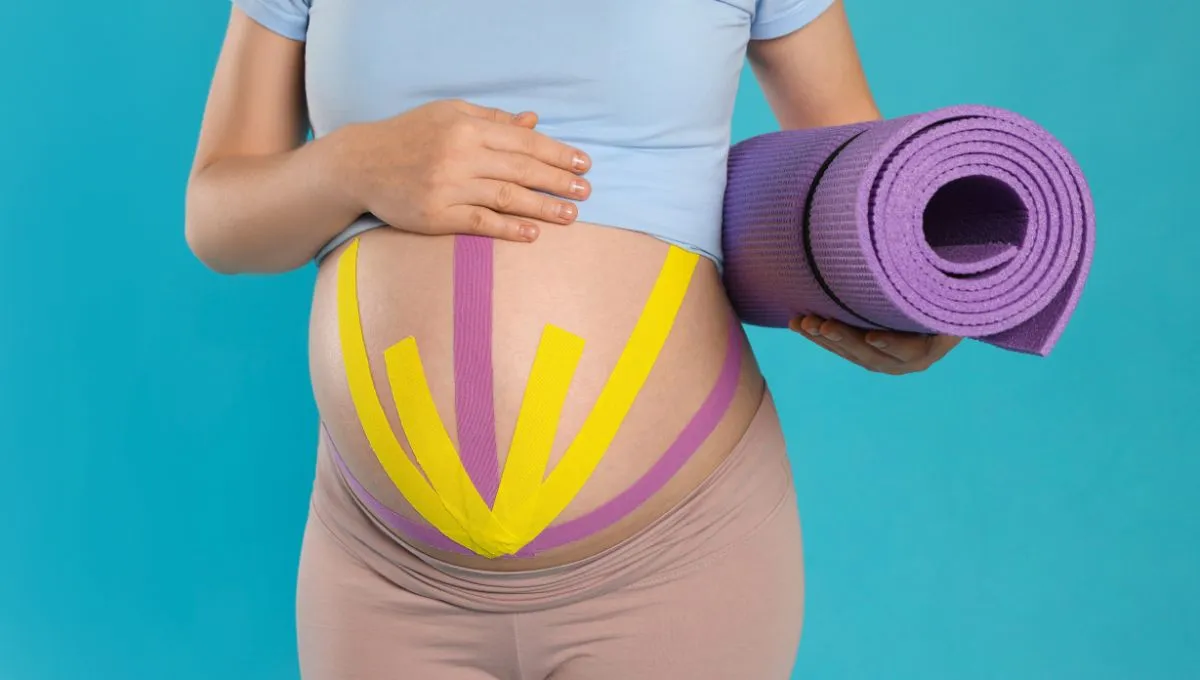
Sciatica refers to pain caused by irritation or compression of the sciatic nerve, which runs from your lower back down through your hips and buttocks and branches down each leg. During pregnancy, sciatica is common as the baby grows, increased fluid retention causes swelling, and your posture and center of gravity shift. The extra weight and pressure on your sciatic nerve can lead to debilitating pain, tingling, and numbness.
KT tape is an elastic sports and fitness tape that can be used to help provide support and pain relief for various issues. Now, you might be wondering about KT Tape for pregnancy sciatica. Though not a cure-all, KT tape may provide noticeable relief from the symptoms of pregnancy sciatica when used properly. Its flexible, adhesive material lifts the skin, which takes pressure off the sciatic nerve for many pregnant women.
Related: Is Pain in Childbirth a Curse from God?
Symptoms of Sciatica in Pregnancy
Sciatica during pregnancy can cause a range of symptoms, most commonly lower back pain, pain radiating down the leg, numbness or tingling sensations, and muscle weakness in the affected leg.
The most telltale symptom is usually pain that radiates from the lower back, down the back of the thigh, and into the leg. It often follows the path of the sciatic nerve, which branches from the lower back through the hips and buttocks and down each leg. This pain tends to be sharp and shooting in nature, and may feel like an electric shock along the path of the nerve. It may be constant or intermittent.
In addition to radiating leg pain, many pregnant women with sciatica experience lower back pain on the affected side. This back pain has a dull, aching quality and ranges from mild to severe.
Numbness or tingling in the leg or foot is also common. This results from compression of the sciatic nerve, which causes sensations in the leg and foot to be dulled or changed. A pins-and-needles sensation may also occur.
Muscle weakness in the affected leg is another symptom. This makes it difficult to move the leg normally, climb stairs, or walk on the affected side. The weakness may come and go.
Other possible symptoms include pain when sitting for long periods, pain when coughing or sneezing, and a limited range of motion in the lower back. Symptoms are usually only on one side of the body. The pain may be worse when standing or lying down.
Related: Painful Sex After Birth: What’s Normal And What’s Not
Causes of Sciatica in Pregnancy
Pregnancy sciatica is often caused by the extra weight and pressure from the growing fetus. As the baby grows, it puts increasing pressure on the sciatic nerve, which runs from the lower back, down the buttocks, and into the legs. This added weight strains the back and pelvis, compressing or irritating the sciatic nerve.
Hormonal changes during pregnancy also contribute to sciatica by loosening ligaments and joints in preparation for childbirth. The hormones estrogen and relaxin cause the pelvic joints and ligaments to loosen and stretch. This shifts the balance and alignment of the pelvis, putting pressure on the sciatic nerve.
As the baby grows in size, especially in the third trimester, they can end up lying right on the sciatic nerve itself. A baby in a breech position is more likely to compress the nerve, causing severe pain and numbness. The baby moving and kicking can also aggravate the irritated nerve.
So in summary, the main causes of pregnancy sciatica are:
- Weight gain putting extra pressure on the back and pelvis
- Hormonal changes loosening ligaments and joints
- Baby growing larger and pressing directly on the sciatic nerve
- Baby in a breech position compressing the nerve
- Baby kicking and moving which aggravates the irritated nerve
Risk Factors for Sciatica in Pregnancy
There are several factors that can increase a pregnant woman’s risk of developing sciatica pain. Some of the main risk factors include:
- Advanced maternal age: Women over 35 are more likely to experience back and nerve pain during pregnancy. The natural degeneration of discs and joints that comes with age makes older mothers more susceptible to sciatica.
- Previous back injury: If a woman already had issues with her lower back or sciatic nerve prior to pregnancy, she is much more prone to sciatica pain during pregnancy. The extra weight and strain of carrying a baby can aggravate existing problems.
- Gaining excessive weight: Pregnant women who gain more than the recommended amount of weight put extra stress on their back and pelvis. This added pressure increases their chances of developing sciatic pain. It’s important to stay within the healthy weight gain range during pregnancy to avoid undue strain on the body.
The third trimester of pregnancy is when women are most likely to experience sciatica symptoms. However, by being aware of the risk factors, staying active, and managing weight gain, mothers-to-be can reduce their likelihood of developing this painful pregnancy complication.
Related: Aches and Pains of Pregnancy: Understanding and Coping
Conventional Treatments for Pregnancy Sciatica
Pregnancy sciatica is typically treated first with conservative methods before considering other options. Some of the most common conventional treatments for sciatica during pregnancy include:
Physical Therapy
Physical therapists can provide personalized exercise programs to stretch and strengthen the back, core and leg muscles. This helps take pressure off the sciatic nerve and reduce inflammation. Physical therapists may use techniques like ultrasound and soft tissue massage as well.
Chiropractic
Chiropractors specialize in adjusting the alignment of the spine to relieve pressure on nerves. They are trained to safely work with pregnant patients. Chiropractic adjustments bring the pelvis, hips and spine back into proper alignment.
Massage
Regular massage is an effective way to relieve muscle tension, stiffness and nerve pain associated with pregnancy sciatica. Therapeutic massage increases circulation, relaxes muscles and can help improve mobility. Massage therapists can show safe techniques for self-massage at home too.
Pain Medications
Over-the-counter medications like acetaminophen or heat/ice therapy may provide temporary relief for mild sciatica. Doctors can prescribe stronger pain medications if OTC options are ineffective, but these carry more risks during pregnancy.
Related: What Are Common Discomforts During Pregnancy?
Introducing KT Tape

KT tape (also known as kinesiology tape or kinesio tex tape) is an elastic cotton strip with an acrylic adhesive that is used to treat a variety of musculoskeletal conditions. Though relatively new on the scene, KT tape has quickly gained popularity, especially among athletes, for treating injuries and pain. It was developed by Dr. Kenzo Kase in the early 1970s. It is safe enough for a baby’s sensitive skin, and gentle enough for aging individuals
So how does it work exactly? KT tape lifts the skin microscopically to improve blood and lymph flow in the taped area. This helps relieve pressure and pain while supporting muscles, joints, and other injured tissues.
The tape can stretch up to 120-140% of its original length longitudinally, which provides a pulling (shear) force to the skin. The latex-free adhesive backing sticks to the skin without restricting range of motion. This allows the body segment to have full mobility while benefiting from the tape’s support.
KT tape is lightweight, flexible, and water resistant, so it can stay on for days at a time, even with exercise and bathing. It comes in a variety of colors, but the nude and flesh-tone colors are recommended for discreet taping during pregnancy.
With its ability to gently lift and support the back and belly, KT tape shows promise as an effective, drug-free option for relieving pregnancy sciatica and related pain.
Related: Why Are My Breasts Not Sore After Ovulation This Month
Using KT Tape for Pregnancy Sciatica
KT tape can provide effective relief when used properly for pregnancy sciatica. The key is following the proper taping techniques specifically for sciatic nerve pain.
When applying KT tape for sciatica, it’s important to place the tape along the path of the sciatic nerve. Start by cutting a strip of tape and rounding the edges to prevent curling.
Apply the first piece of tape starting from the lower back, over the buttock, and down the back of the thigh. Use an I-strip technique going around the thigh to cover the entire path of the sciatic nerve. Use a rubbing motion to activate the adhesive.
You can add a second strip of tape in the same area if needed for additional support and pain relief. Always stretch the tape 50-75% of its length when applying for the optimal effect.
It’s best to keep the tape on for 3-5 days, replacing once it starts to lift at the edges. Be sure to allow at least 8-12 hours between tape changes to let the skin rest.
When removing the tape, do so slowly and carefully. Apply oil or lotion to help dissolve the adhesive. Never rip the tape off quickly as this can further aggravate the inflamed nerves.
Some precautions when using KT tape during pregnancy include:
- Avoid taping over open wounds or infected skin
- Watch for signs of allergic reaction to the adhesive
- Speak with your doctor if you have any concerns
With proper taping technique, KT tape can provide safe, drug-free relief from sciatica pain during pregnancy. Just be sure to use caution and remove the tape if you experience any discomfort or adverse effects.
Related: Is Zipline Safe for Pregnant Women
KT Tape vs. Other Treatments
KT tape has several advantages over other treatment options for pregnancy sciatica. Unlike pain medications, KT tape is completely drug-free. This makes it very safe for pregnant women and developing babies. KT tape also does not require specialized equipment or a trained professional for application. Women can easily apply KT tape themselves at home as needed for pain relief. At around $20 per roll, KT tape is very affordable compared to some other options like chiropractic or massage therapy.
KT tape works by lifting the skin and allowing improved blood flow to the area. The gentle pulling of the tape relieves pressure on the sciatic nerve. KT tape can provide pain relief for up to a few days with one application. The tape is also completely waterproof and can be worn during exercise, bathing, or in hot and humid weather. It moves with the body and is very comfortable for long-term wear.
KT tape is non-invasive and has minimal risks. It can be combined safely with many other treatments. The tape should not restrict movement or circulation. Women who are considering KT tape for pregnancy sciatica should still discuss options with their healthcare provider. But KT tape provides an excellent drug-free option that can be self-administered as needed. For many women, KT tape is an affordable way to find effective relief from sciatica pain during pregnancy.
Related: Can Pregnant Women Park In Handicap Spaces
Lifestyle Changes to Complement KT Tape
KT tape can provide relief from pregnancy sciatica symptoms, but incorporating lifestyle changes is also key. There are several ways you can complement KT tape treatment to find greater comfort during pregnancy.
Exercises and Stretches
Certain exercises and stretches that strengthen muscles in the back, abdomen and hips can significantly reduce sciatic nerve pain. Try pelvic tilts, knee to chest stretches, cat/cow pose, and squats against a wall. Aim to do light stretches daily. Prenatal yoga also helps relax muscles and improve flexibility.
Massage
Massaging the lower back and hips can release muscle tension that contributes to sciatica. Have your partner gently massage the outer hip over the piriformis muscle and lower back where the sciatic nerve runs through. Use circular motions and medium pressure. Massage therapy promotes circulation and signals pain relief to the brain.
Good Posture
Practice good posture by sitting and standing tall, with shoulders back. Avoid slouching or hunching over, which puts more pressure on the sciatic nerve. Wear flat, supportive shoes and place a pillow behind your lower back when sitting. Sleep on your side with a pillow between your knees. Maintaining proper spinal alignment takes pressure off compressed nerves.
Staying Active
While resting when pain flares up, avoid long periods of inactivity. Gentle walking, swimming and stationary cycling help keep muscles loose and flexible. Make sure to change positions frequently and shift your weight from one side to the other. Light activity promotes blood flow to help heal irritated nerves.
With some lifestyle adjustments, KT taping can be even more effective at relieving pregnancy sciatica. Be patient as you find the right combination of stretches, exercises and self-care to complement the tape.
When to See a Doctor
It’s important to consult your doctor if your sciatica pain becomes severe or worsens, you experience muscle weakness, or you lose control of your bowel and bladder functions. These can be signs of a serious medical issue requiring immediate treatment.
Severe or Worsening Pain
While most cases of pregnancy sciatica are manageable with conservative treatments like KT tape, worsening pain that fails to improve with treatment warrants medical attention. Severe or worsening sciatic pain could signal a herniated disc, piriformis syndrome or other causes that may require interventions beyond KT tape and lifestyle modification. Don’t try to tough it out if your pain becomes extreme or continues to intensify. Seek medical care to identify the underlying cause and find more effective relief.
Muscle Weakness
Increasing numbness, tingling or weakness in the leg or foot on the affected side are red flags. This may indicate impingement or compression of spinal nerve roots in the lower back. Weakness in the legs, problems moving the ankle or difficulty lifting the foot up are reasons to promptly consult your doctor. Left untreated, nerve impingement can lead to permanent nerve damage.
Loss of Bladder/Bowel Control
Losing control of bladder and bowel functions alongside sciatica is an emergency requiring immediate medical care. This symptom, called cauda equina syndrome, results from severe compression of spinal nerve roots in the lower back. It’s crucial to seek emergency treatment to avoid permanent loss of bowel, bladder and sexual functions. Consult your OBGYN or visit the ER if you experience these serious symptoms alongside pregnancy sciatica. Don’t wait to see if it improves on its own.
Conclusion
In summary, worsening pain, muscle weakness and loss of bladder/bowel control warrant urgent medical evaluation. While KT tape may provide relief for mild pregnancy sciatica, more serious cases require proper diagnosis and treatment to avoid complications. When in doubt, have your doctor assess your symptoms.












